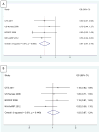Reproductive factors and menopausal hormone therapy and bladder cancer risk in the NIH-AARP Diet and Health Study
- PMID: 23319449
- PMCID: PMC3646919
- DOI: 10.1002/ijc.28022
Reproductive factors and menopausal hormone therapy and bladder cancer risk in the NIH-AARP Diet and Health Study
Abstract
The incidence of bladder cancer among women is at least one-third to one-fourth that observed among men in many countries. Even after accounting for known risk factors, the reason for this gender disparity remains unexplained. We conducted a comprehensive evaluation of reproductive factors and exogenous hormone use with a primary focus on menopausal hormone therapy use and risk of bladder cancer in women in the NIH-AARP Diet and Health Study. Reproductive and hormonal factors were ascertained on the baseline questionnaire in 1995-1996 among 201,492 females who were followed until December 31, 2006. During follow-up, 651 cases of bladder cancer were diagnosed. A subset of women provided detailed information on use of MHT in a second questionnaire in 1996-1997. In this analysis, 127,361 females were followed through June 30, 2002 and 198 incident bladder cancer cases were identified. Cox proportional hazard models, adjusted for smoking status, cigarettes per day and body mass index using age as the time metric, were used to obtain hazard ratios (HRs). A reduced risk was observed among parous women (HR=0.76; 95% CI 0.62-0.93) and women who reported late age at menarche (≥15 years) (HR=0.57; 95% CI 0.39-0.84). Women who reported ever using estrogen and progestin therapy had a decreased risk (HR=0.53; 95% CI: 0.34-0.83) compared with women who did not report MHT use. No association was observed for estrogen only users (HR=0.82; 95% CI: 0.58-1.15). Our results suggest a putative role for sex hormones in the etiology of bladder cancer among women.
Copyright © 2013 UICC.
Figures
Similar articles
-
Unopposed estrogen and estrogen plus progestin menopausal hormone therapy and lung cancer risk in the NIH-AARP Diet and Health Study Cohort.Cancer Causes Control. 2012 Mar;23(3):487-96. doi: 10.1007/s10552-012-9904-2. Epub 2012 Feb 25. Cancer Causes Control. 2012. PMID: 22367699 Free PMC article.
-
Use of postmenopausal hormone therapies and risk of histology- and hormone receptor-defined breast cancer: results from a 15-year prospective analysis of NIH-AARP cohort.Breast Cancer Res. 2020 Nov 25;22(1):129. doi: 10.1186/s13058-020-01365-9. Breast Cancer Res. 2020. PMID: 33239054 Free PMC article.
-
Hormonal and reproductive factors and risk of postmenopausal thyroid cancer in the NIH-AARP Diet and Health Study.Cancer Epidemiol. 2011 Dec;35(6):e85-90. doi: 10.1016/j.canep.2011.05.009. Epub 2011 Aug 17. Cancer Epidemiol. 2011. PMID: 21852218 Free PMC article.
-
[Hormone replacement therapy in menopause and risk of breast cancer].Presse Med. 2000 Oct 21;29(31):1688-93. Presse Med. 2000. PMID: 11094609 Review. French.
-
Breast Cancer and Menopausal Hormone Therapy by Race/Ethnicity and Body Mass Index.J Natl Cancer Inst. 2015 Nov 5;108(2):djv327. doi: 10.1093/jnci/djv327. Print 2016 Feb. J Natl Cancer Inst. 2015. PMID: 26546117 Free PMC article. Review.
Cited by
-
A Review of the Etiology and Epidemiology of Bladder Cancer: All You Need To Know.Cureus. 2022 Jul 27;14(7):e27330. doi: 10.7759/cureus.27330. eCollection 2022 Jul. Cureus. 2022. PMID: 36042998 Free PMC article. Review.
-
Clinical and therapeutic implications of sex steroid hormone receptor status in urothelial bladder cancer.Indian J Urol. 2020 Jul-Sep;36(3):171-178. doi: 10.4103/iju.IJU_320_19. Epub 2020 Jul 1. Indian J Urol. 2020. PMID: 33082631 Free PMC article. Review.
-
Emerging drivers of female bladder cancer: a pathway to precision prevention and treatment.Front Oncol. 2025 Feb 14;15:1497637. doi: 10.3389/fonc.2025.1497637. eCollection 2025. Front Oncol. 2025. PMID: 40027137 Free PMC article.
-
Analysis of the prognostic relevance of sex-steroid hormonal receptor mRNA expression in muscle-invasive urothelial carcinoma of the urinary bladder.Virchows Arch. 2019 Feb;474(2):209-217. doi: 10.1007/s00428-018-2496-9. Epub 2018 Nov 27. Virchows Arch. 2019. PMID: 30483954
-
Natural products as a means of overcoming cisplatin chemoresistance in bladder cancer.Cancer Drug Resist. 2021 Mar 19;4(1):69-84. doi: 10.20517/cdr.2020.69. eCollection 2021. Cancer Drug Resist. 2021. PMID: 35582013 Free PMC article. Review.
References
-
- Silverman DT, Devesa SS, Moore LE, Rothman N. Bladder Cancer. In: Schottenfeld D, Fraumeni JF Jr, editors. Cancer Epidemiology and Prevention. 3. New York: Oxford University Press; 2006. pp. 1101–1127.
-
- Hartge P, Harvey EB, Linehan WM, Silverman DT, Sullivan JW, Hoover RN, et al. Unexplained excess risk of bladder cancer in men. J Natl Cancer Inst. 1990;82(20):1636–1640. - PubMed
-
- Imada S, Akaza H, Ami Y, Koiso K, Ideyama Y, Takenaka T. Promoting effects and mechanisms of action of androgen in bladder carcinogenesis in male rats. Eur Urol. 1997;31(3):360–364. - PubMed
-
- Tanahashi NK, Suzawa N, Azuma C. Effects of sex hormones on oncogenesis in rat urinary bladder by N-butyl-N-(4-hydroxybutyl)-nitrosamine. Int J Clin Pharmacol Biopharm. 1977;15(3):101–105. - PubMed
-
- Miyamoto H, Yang Z, Chen YT, Ishiguro H, Uemura H, Kubota Y, Nagashima Y, Chang YJ, Hu YC, Tsai MY, Yeh S, Messing EM, et al. Promotion of bladder cancer development and progression by androgen receptor signals. J Natl Cancer Inst. 2007;99(7):558–568. - PubMed
Publication types
MeSH terms
Substances
Grants and funding
LinkOut - more resources
Full Text Sources
Other Literature Sources
Medical


